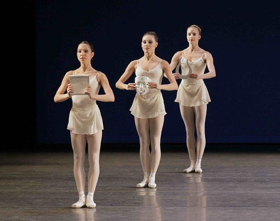Review: New York City Ballet brings to the stage the Balanchine Classics

BWW Review: New York City Ballet brings to the stage the Balanchine Classics
The David H. Koch Theater on Saturday January 27, 2018 during the matinee of the New York City Ballet featured three works choreographed by George Balanchine. These included Apollo, Mozartiana, and Cortege Hongrois.
An announcement was made by principal dancers Jared Angle and Megan Fairchild that the matinee performances were being dedicated to George Balanchine. It was mentioned that Apollo was the first ballet choreographed by Mr. B at the age of 24.
Apollo
Apollo, with music by Igor Stravinsky featured principal dancers Adrian Danchig-Waring and Tiler Peck, with Soloists Ashly Isaacs and Indiana Woodward. As the curtain rose, we were privy to a true "Greek god". The miming, suppleness of movements and leaps executed by Mr. Danchig-Waring were extraordinary. The three women were drawn to this "god - man" with true reverence. The ballerinas danced in tandem and really appeared as one. Apollo conveyed the role of puppeteer with Mr. Balanchine's masterful choreography.
The penches of the ballerinas were deep and controlled. Throughout the solos of the muses, Apollo remained impassive to create the illusion of a Greek statue. With the completion of the final solo, Apollo stands and by raising his arm, this becomes the only time when he expresses how he feels. As Apollo dances his solo, the muses become his captive audience. The pas de deux begins in a non-traditional way with Mr. Danchig -Waring kneeling on the ground as Ms. Peck dances over and around him. The traditional series of lifts do arrive to complete the variation.
This piece is very physical for a male dancer and requires quite a lot of stamina. It is understandable that I noticed Mr. Danchig-Waring's diaphragm which seemed to heave in a reaction to the partnering required with the three muses. The performance was of a high caliber and the audience rewarded the dancers with enthusiastic cheers and applause.
Mozartiana
Mozartiana with music by Peter Ilyitch Tschaikovsky (Suite No. 4, Op. 61) began with
"Preghiera" performed by principal dancer Sara Mearns. She was accompanied by four young ballerinas. In contrast with the children, her dancing appeared heavy and not as light as she is known for in other performances. The juxtaposition of the girls together with Ms. Mearn's costume led to a less than true outcome worthy of her talents.
"Gigue" followed with Troy Schumacher who delivered a stellar performance. As he glided onto the stage in a sylph like manner, he regaled the audience with masterful leaps. The four soloists who accompanied him added to this wonderful performance.
"Theme and Variations" returned Sara Mearns to the stage. Her performance was better as a solo. She was animated and delighted the audience with her strengths. Chase Finlay dressed in white tights and a wine colored vest that became the perfect compliment to his array of leaps and twirls. Mr. Finlay delivered a visibly polished performance and was awarded with enthusiastic applause.
As the Finale progressed, the combination of Ms. Mearns, Mr. Schumacher, and the children gave the audience the delightful conclusion to a masterful piece created by Mr. George Balanchine.
Cortege Hongrois
Cortege Hongrois with music by Alexander Glazunov (from Raymonda) heralded the final piece to this inspired matinee. Before the performance commenced, an announcement had been made to say that the part originally scheduled for the principal dancer Andrew Veyette would be performed by principal dancer Russell Janze.
The opening scene treated us to a series of well executed and regal promenades. The white and green costumes created the illusion of a true Royal Court. The "Czardas", although technically precise, lacked the much needed energy which is usually exhibited with this style of dance. The steps were slower, lacked visceral movements, and were too soft. The "Pas de Quatre" variation was performed in a true manner reminiscent of the great Russian style. It was wonderful to witness this group which followed the choreography created by George Balanchine to such a high level of performance.
The "Variations I, II, III, IV" performed by both principal and soloist dancers exhibited a combination of well-honed expertise and craft of superior performance levels.
The "FINALE" proved to be a fitting and worthwhile conclusion to an afternoon at the ballet.
Photo Credit: Saratogian News
Add Your Comment
Play Broadway Games
Videos





%20(1024%20×%20512%20px).png)
